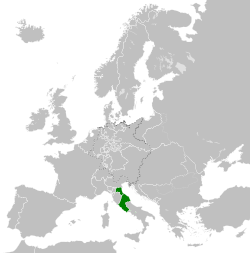
Back Kirchenstaat ALS Estaus Pontificios AN الدولة البابوية Arabic الدوله البابويه ARZ Estaos Pontificios AST Papa dövləti Azerbaijani پاپ دؤولتی AZB Папская вобласць Byelorussian Папская дзяржава BE-X-OLD Папска държава Bulgarian
State of the Church Stato della Chiesa Status Ecclesiasticus | |
|---|---|
| 754–1870 Interregna (1798–1799, 1809–1814 and 1849) | |
Anthem:
| |
 The Papal States in 1815 after the Napoleonic Wars | |
 Map of the Papal States (green) in 1700, including its exclaves of Benevento and Pontecorvo in Southern Italy, and the Comtat Venaissin and Avignon in Southern France. | |
| Capital | Rome |
| Common languages | Latin, Italian, Occitan |
| Religion | Roman Catholic |
| Government | Theocratic absolute elective monarchy |
| Pope | |
• 754–757 | Stephen II (first) |
• 1846–1870 | Pius IX (last) |
| Cardinal Secretary of State | |
• 1551–1555 | Girolamo Dandini (first) |
• 1848–1870 | Giacomo Antonelli (last) |
| Prime Minister | |
• 1848 | Gabriele Ferretti (first) |
• 1848 | Giuseppe Galletti (last) |
| History | |
• Establishment | 754 |
| 781 | |
• Treaty of Venice (independence from the Holy Roman Empire) | 1177 |
| February 15, 1798 | |
| May 17, 1809 | |
| September 20, 1870 | |
| February 11, 1929 | |
| Population | |
• 1853[1] | 3,124,668 |
| Currency |
|
| Today part of | |
Preview warning: Page using Template:Infobox country with unknown parameter "region"
The Papal States, officially the State of the Church (Italian: Stato della Chiesa, Italian pronunciation: [ˈstato della ˈkjɛːza]; Latin: Status Ecclesiasticus;[2] also Dicio Pontificia), were a series of territories in the Italian Peninsula under the direct sovereign rule of the Pope, from the 8th century until 1870.
By 1861, much of the Papal States' territory had been conquered by the Kingdom of Italy. In 1870, the Pope lost Lazio and Rome and had no physical territory at all, except the Vatican.
- ↑ Statistica della popolazione dello Stato pontificio dell'anno 1853 (PDF). Ministero del commercio e lavori pubblici. 1857. p. XXII. Archived from the original (PDF) on 2 March 2018. Retrieved 1 March 2018.
- ↑ Frederik de Wit, "Status Ecclesiasticus et Magnus Ducatus Thoscanae" (1700)

